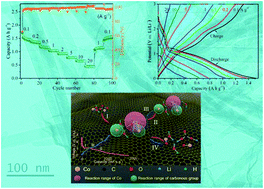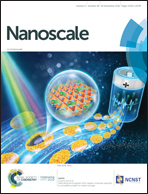3D architectures with Co2(OH)2CO3 nanowires wrapped by reduced graphene oxide as superior rate anode materials for Li-ion batteries†
Abstract
Open porous 3D architectures with Co2(OH)2CO3 nanowires wrapped by highly conductive reduced graphene oxide films are designed and exploited for the first time as anodes for lithium ion batteries; the materials were fabricated via one-step hydrothermal synthesis and self-assembly based on the electrostatic interaction and coordination principle and delivered superior rate performance (1510 and 445 mA h g−1 at 0.1 and 20 A g−1, respectively) and long cycle stability (5000th reversible capacity of 550 mA h g−1 at 10 A g−1). This extremely encouraging result is attributed to the open porous 3D networks and ultrafine diameters of the nanowires, which achieved better electrical contact between the active materials and shortened the ion/electron transport paths; this highlights the synergistic effect of combining the Co2(OH)2CO3 nanowires and rGO films. Especially, the hydroxide (LiOH) can provide a good skeleton structure, ionic conductivity and fast kinetics. Additionally, the lithium storage mechanism of the Co2(OH)2CO3/rGO electrode has been elaborately studied. This work not only enlightens the design of open porous 3D architecture hybrid anode materials of transition-metal hydroxyl carbonates with great potential prospective applications for high energy lithium storage, but also provides a new strategy to construct graphene-based composite materials via the coordination principle and molecular self-assembly theory to achieve more functional materials.



 Please wait while we load your content...
Please wait while we load your content...